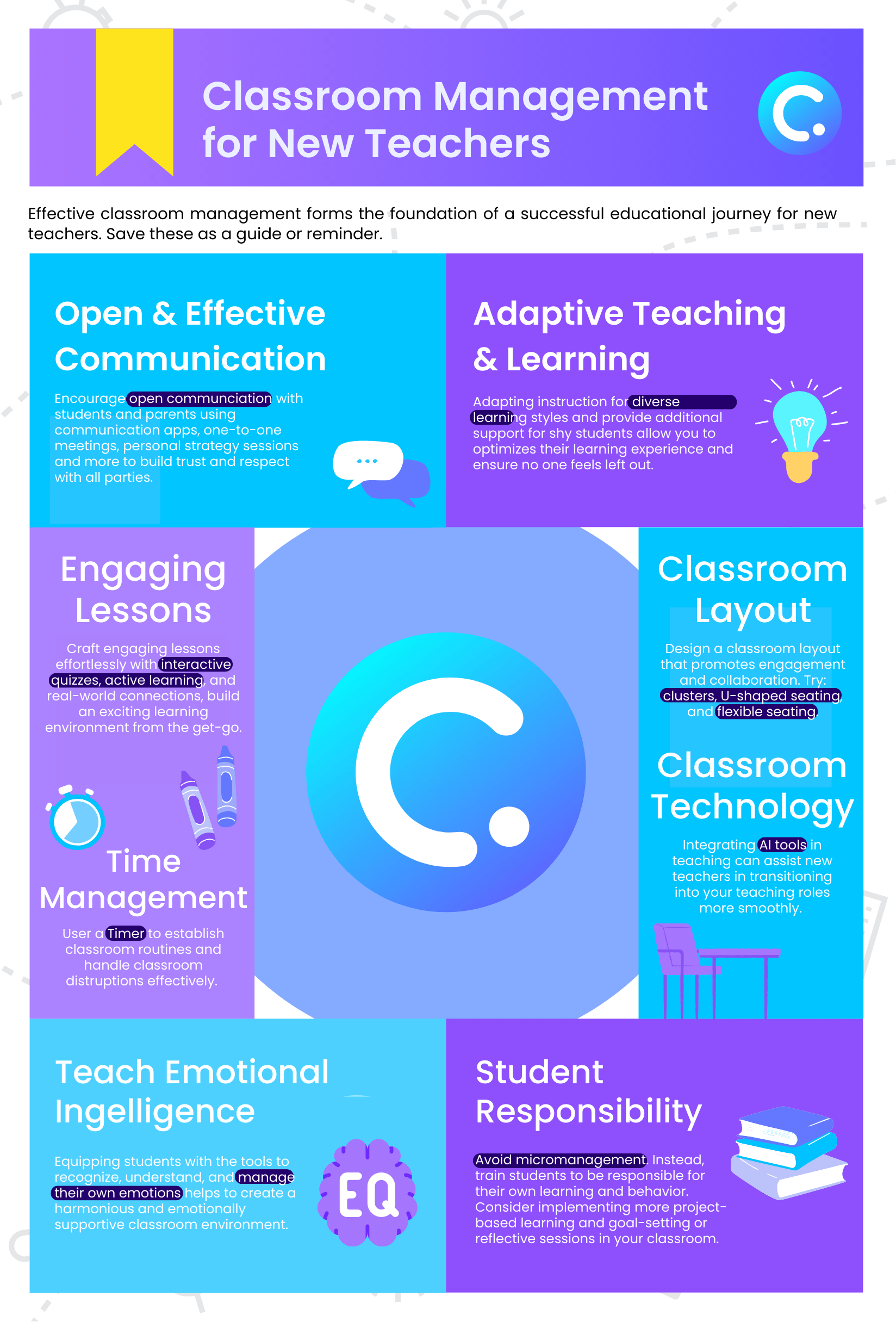Classroom management strategies are essential for any new teacher. Without a proper plan, chaos can ensue, leaving students and teachers feeling overwhelmed and frustrated.
Effective classroom management forms the foundation of a successful educational journey. From establishing routines to developing positive relationships, you can create an inclusive, stimulating, organized, and ideal learning environment that maximizes student potential with the following 26 classroom management strategies for new teachers strategies and tips.
Remember, every classroom is unique, so adapting these strategies to your specific environment is key to success.
26 Classroom Management Strategies for New Teachers

1. Foster positive communication with families

Use tools like communication apps, meetings, and emails to connect to parents and guardians. The adults in students’ lives can better support classroom expectations and reinforce learning at home. Building up their trust in you will help to emphasize that students and begin a relationship to continue benefiting students’ well-being and success.
2. Model values you want to see in your classroom
As a new teacher, it is undoubtedly challenging to establish a positive classroom environment. The values you exhibit as a teacher set the tone for your classroom and instill essential life skills. By consistently modeling the values you wish to instill throughout your teaching and in your classroom activities, such as respect, empathy, and diligence, you create a foundation for students to emulate and integrate into their behavior.
3. Balance structure and adaptability
Striking a balance between routines and flexibility in the classroom provides students with the stability they need to thrive while accommodating their diverse learning needs and preparing them for the dynamic challenges of the future. Routines provide students with a sense of security and predictability, enabling them to focus on learning, but being flexible helps them adapt and prepare for life outside the classroom. It takes time to establish a classroom routine as a new teacher, but here is how you can do so with the help of a timer.
4. Adapt instruction for diverse learning styles

Adapting instruction for diverse learning styles recognizes the uniqueness of each student and optimizes their learning experience. Try one of these differentiated learning strategies and use visual aids throughout class for visual learners as well as include discussions and hands-on activities for auditory and kinesthetic learners respectively. This ensures that all students can access and engage with the material effectively.
5. Hold attention with crafted engaging lessons

Set the stage for the year and your teaching style by capturing students’ attention and fueling their curiosity with interactive activities or quizzes, active learning, real-world connections, and varied resources. Engaging students throughout the whole lesson helps to build an environment where learning is exciting and meaningful.
Pro tip: ClassPoint AI can help you automate the process of quiz generation for engaging lessons in just a few clicks.
6. Maintain a focused atmosphere
Smooth transitions and well-managed activities help sustain a productive classroom environment. If you start the year with clunky transitions, students could expect those free moments to continue and begin chatting with friends, taking more time out of your lesson to bring them back to focus. With minimal disruptions, the learning momentum stays focused on the task at hand with no moments to get distracted, putting a pause in learning for the whole class.
7. Focus and flow with strategic time management
Adopting strategic time management practices early in your teaching career provides a strong foundation for personal and professional growth. You can optimize your impact in the classroom, develop a healthy work-life equilibrium, and maintain student interest throughout the class. By optimizing the use of class time with these 10 effective ways, students remain engaged and you can seamlessly navigate through various lesson components.
Need help with time management? Learn how to add a timer to your PowerPoint presentation to ensure you never lose track of time again while presenting.
8. Clear guidance and task simplification
When starting a class or academic year as a new teacher, one of the best classroom management strategies for new teachers is establishing a strong foundation for effective instruction by providing clear instructions right away is crucial. Students thrive when they understand expectations and can approach tasks without feeling overwhelmed. This structured and efficient learning environment supports student understanding, engagement, and success.
9. Diversify feedback approaches

Begin building your teaching identity with different types of feedback to make better connections with students. Cater to different learning preferences and encourage a growth mindset by rotating through effective feedback approaches. Try changing up formats of feedback with peer assessment, self-assessment, and constructive feedback.
10. Enforce consistent consequences
When students understand the consequences of their actions, it contributes to a safe and orderly classroom environment, saving you time to handle these disruptions during class as a new teacher. Without resorting to yelling or punishing, enforce consistent consequences to help students understand the outcomes of their actions. A calm and respectful approach to discipline fosters a safe and respectful classroom environment.
11. Recognize achievements of all kinds
Recognizing achievement, no matter how big or small, is one of the simplest classroom management strategies for new teachers to start with. Build a culture of support and respect in your classroom by recognizing achievements, whether academic, personal, or social. It fosters a love for learning, a sense of belonging, and a mindset of continuous improvement, laying the foundation for students’ lifelong success and well-being.
Recognize success with different question types.
12. Roam the classroom

For new teachers, it may take students some time to get comfortable approaching you. When you move around your classroom, instead of being tied to your desk, you promote a sense of accessibility and approachability. You can easily connect with students individually, address questions, and gauge their engagement.
13. Set the tone with a unique classroom layout
A tried and tested classroom management strategise for new teachers is having a well-designed classroom layout. The classroom layout impacts engagement, collaboration, interaction, and overall classroom atmosphere. Set your teaching philosophy to match a well-designed layout that caters to various learning needs, promotes inclusivity, and contributes to a positive and conducive learning environment. Change up your layout periodically with traditional rows, clusters, U-shaped seating, flexible seating, and more.
14. Continuously evolve with technology
Incorporating technology and AI in Education can significantly enhance student engagement and make learning more dynamic and captivating. Additionally, it can assist new teachers like you in transitioning into your teaching roles more smoothly. Integrating educational technology like ClassPoint or AI teaching tools enhances lessons, supports personalized learning, and prepares students for a tech-driven world. As a new teacher, you have fresh eyes to new technology, making it easier to incorporate and mold into your classroom and teaching plans.
Here are 46 AI teaching tools and ChatGPT alternatives to try, and here are the 7 best AI teaching tools for your convenience.
15. Nurture growth with self-reflection
Encouraging students to engage in self-reflection empowers them to assess their progress, set personal goals, and take ownership of their learning journey. Through introspection, students become more aware of their strengths and areas for improvement, fostering a growth mindset that supports continuous development.
For yourself, nurturing growth through self-reflection allows you to adapt, improve, and excel in your teaching while fostering a lifelong commitment to learning and development.
16. Collaborate and communicate = cooperative classroom

Effective classroom management extends beyond the teacher-student dynamic. It encompasses fostering collaboration among students and maintaining open communication with parents or guardians. When you all learn to work together, you gain a deeper understanding of diverse perspectives, building a foundation for respectful and inclusive interactions both in and out of the classroom.
17. Empower students with conflict-resolution skills
Empower students through role-play practice, discussions, and case studies to address disagreements and challenges constructively is one of the most effective classroom management strategies for new teachers. These activities help to teach effective communication, active listening, and problem-solving strategies. The ability to navigate conflicts in a respectful and collaborative manner is a skill that all new teachers need to possess in order to foster a positive and harmonious classroom atmosphere.
18. Teach and develop emotional intelligence
Daniel Goleman’s book, Emotional Intelligence: Why It Can Matter More Than IQ, claims that emotional intelligence is more important than IQ. Equip students with the tools to recognize, understand, and manage their own emotions, as well as empathize with others. By fostering empathy and self-awareness, students can navigate conflicts and interpersonal relationships more effectively, creating a harmonious and emotionally supportive classroom environment.
19. Don’t leave the shy students behind

Help the shy students thrive in your classroom by learning their names, using icebreakers, making them feel included, and providing choices. As a new teacher, it helps to be extra patient, and consistently applying different strategies, and adapting them based on each student’s comfort level and progress. Your support and encouragement can make a significant difference in helping shy students thrive in your classroom.
20. Constantly work to build a positive classroom culture
A classroom culture is not just built in a day – begin the process from your Day 1 and continue to build day in and day out. A positive classroom culture is integral to student engagement and overall well-being. Nurture a sense of belonging, respect, and collaboration among students, while constantly offering motivation to inspire enthusiasm for learning and create lasting memories.
Here are a few tips to increase student motivation and positive classroom culture with gamification.
21. Establish clear expectations from the start
Outline behavior guidelines, academic standards, and classroom routines, to foster discipline and accountability. This classroom management strategy for new teachers minimizes misunderstandings and helps students understand the standards that contribute to a productive and consistent learning environment. When you begin in the way you want to continue, time and effort are saved for both you and your students.
22. Maximize student responsibility
Many new teachers tend to engage in micromanagement. However, when students are responsible for their own learning and behavior, your role shifts from micromanaging to facilitating, allowing more time for instruction and support. Encouraging students to take responsibility for their learning and behavior through project-based learning and goal-setting or reflection sessions fosters independence and accountability. This entrusts students to become active participants in their own learning, prepares them for the challenges of the future, and contributes to a positive classroom culture.
23. Initiate personal strategy sessions

New teachers can make a significant impact on students’ academic progress and self-development when supporting them through 1:1 sessions. Conducting these sessions with students shows personalized attention and care. These sessions provide an opportunity to understand individual needs, strengths, and goals, enhancing the teacher-student relationship.
24. Actively listen to students
When starting to teach, show students the respect they give you when listening to your teaching. For a student-centered classroom environment, actively listen to students’ thoughts, concerns, and feedback. This shows that their voices are valued, fosters trust, encourages open communication and ensures a student-centered classroom environment.
25. Tackle individual issues on a one-on-one basis
Addressing issues individually is one of the classroom management strategies many new teachers adopt. It allows you to provide tailored guidance and support based on each student’s unique needs, strengths, and challenges. Keeping issues private builds trust validates students’ feelings, and helps you both to create a personalized solution to the issue. As a new teacher, this is important to keep in mind when starting to build rapport and commitment to each and every student.
26. Take advantage of non-verbal communication
Creating a well-rounded classroom experience by utilizing non-verbal cues, such as body language, facial expressions, and gestures, can reinforce messages and classroom expectations. It is often overlooked but is one of the most essential classroom management strategies for new teachers. These cues have a positive effect on students’ learning provide additional clarity and support effective communication with students.
Here are 20 additional effective classroom management strategies for all teaching levels and subjects.
Effective classroom management serves as the bedrock upon which a successful educational experience is built. By adopting a comprehensive approach that encompasses a range of classroom management strategies for new teachers, you can create an environment that is inclusive, stimulating, and organized. From fostering positive communication with families to modeling the values that define the classroom culture, each strategy plays a vital role in shaping the learning journey for students.
Keep a copy of these strategies handy with our downloadable PDF!
